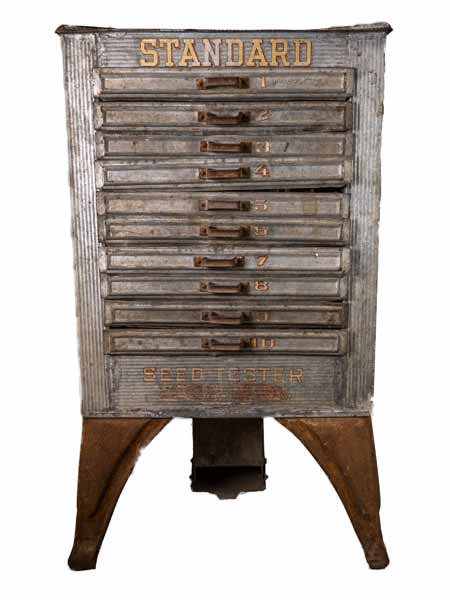Standard Seed Tester c. 1915
This seed tester was manufactured in Decorah, IA by the Standard Seed Tester Company. It was used in Decorah by the Adams Seed Company to see if seeds would germinate. Seeds would be placed on blotter paper and put in one of the numbered drawers. There is a hole on top for even watering. There is a fire box on the bottom to warm the seeds to the correct temperature. This model is the “jumbo” size. There is rosemåling, a traditional form of decorative folk art which originated in Norway, on the side of this unit, possibly to better market the item to Norwegian-Americans of the time or to represent the Norwegian heritage of the Decorah area.
- Artifact: Standard Seed Tester
- Date: 1915
- Museum Location: Vesterheim Norwegian-American Museum, Decorah, IA
Press and zoom in the image below to see details of the object.

Transcript
Jennifer Kovarik, Registrar, Vesterheim Norwegian-American Museum: This is a seed tester, used for testing seeds to see if they would germinate and produce the plants that you needed to have. So it's just a sort of big box. It's made out of metal, and has metal drawers here, and each one of these drawers is where you would put the seeds. In there are little compartments. You put some blotter paper in there, and put the seed in there to germinate.
It’s got a little hole on top for watering through these drawers, and watering evenly, and down here at the bottom there is a little heater. So you can warm these seeds to the right temperature for them to be able to germinate, or to start to sprout. And so each drawer could hold a different kind of seed. They're all numbered, so you could keep track of that, and this one happens to be what they call the “jumbo size,” so it's quite large, and perhaps larger than you would need at your home. So that means that this was probably used for a business, or somebody who had larger needs in terms of seed production. And you can germinate any kind of seeds, whether those would be seeds for corn, any kind of crops you'd be putting into your fields, or the beautiful flowers that you might be growing in your front yard there. And this particular model, or this version here was produced by the Adams Seed Company here in Decorah.
The sort of style on the sides here where you see the details, is sort of similar in terms of the coloring and whatnot of these here, so I'm guessing that it shipped with that, and I don't think that's entirely unusual. In fact, in our collection, we have a number of things that you wouldn't normally think would be decorated, but it was used to sell the pieces. We have farm implements that have painting on them, or sort of these decorations, in fact, we have this sort of planter box that has some rosemaling on it, possibly in hopes that some Norwegian-American farmer would find that really appealing to buy. And I think that we do this today, you know, you're not so excited about buying something that doesn't look good. And so you appeal to people, to their sensibilities. So we know kind of what they like. Otherwise this is pretty drab, I mean it's gray, it does look very utilitarian. So how can we dress this up so that it's a little bit more appealing?
Artifact provided courtesy of the Vesterheim Norwegian-American Museum, Decorah, IA.
